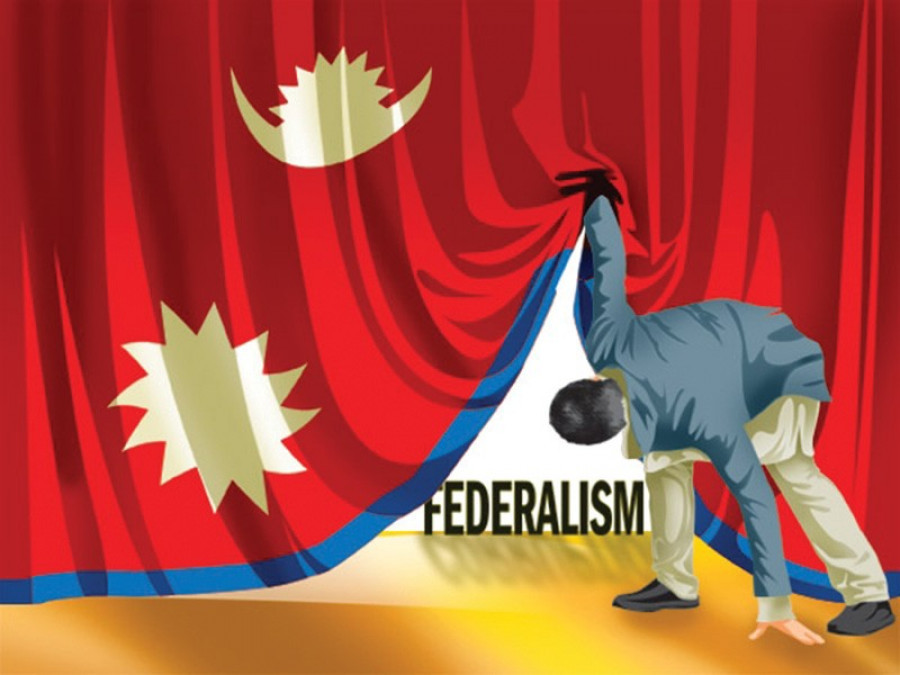Columns
Nepal’s federal fed-up
The institutionalisation of federal intervention will erode provincial democracy and autonomy.
Semanta Dahal
After a protracted and bitterly contested constitution-making process, seven provinces and 753 local units were carved into the map of Nepal to embrace federalism. During the constitutional debates, the anti-federalists frequently relied on the metaphor of cutting a cake to rile against federalism, arguing that Nepal is not a cake to be divided into arbitrary pieces. The cake metaphor remains relevant even today, if not from the viewpoint of cutting it, then for blending and layering it to describe the nature of power-sharing introduced by Nepali federalism and, especially, whether the political power to constitute a government coalition has been handed down to the provinces.
Identity and capacity
Nepal fairly expeditiously jettisoned a historically unitary state for a federal polity in the aftermath of protests organised in Tarai regions against the Interim Constitution for not explicitly acknowledging the expression “federalism”. From that moment onwards and until the promulgation of the Constitution in 2015, the political notion of “identity and capability” were the two conjoined words that the political parties frequently drew assistance from to portray the imagination of a federal Nepal.
The constitutional framers, particularly the State Restructuring Committee of the first Constituent Assembly, went to lengths to even expound on the meaning of “identity and capability”. Identity, the major notion, was described to include five factors: (a) ethnicity/community; (b) language; (c) culture; (d) geographical/territorial continuity; and (e) historical continuity. The minor notion of capability covered four factors: (a) economic interrelations and existing capability; (b) the present state of or potentiality for infrastructural development; (c) the availability of natural resources, and (d) administrative accessibility. In hindsight, many of these factors and sub-factors were simply a stratagem adopted by political parties inclined towards “identity-based” federalism back in the constitution-making days because, eventually, these factors were either ignored or glossed over to draw the internal boundaries to establish the seven states. Besides one ethno-federal province in the Tarai region, factors of geographical/territorial continuity prevailed over ethnic and viability considerations to create the other six provinces. Moreover, following the elections to the provincial assemblies, geographical connotations received more attention as opposed to ethnic elements for coining the names of the provinces.
The cake simile
There are many different characteristics of federalism, but one feature—flaws—is permanent in any model, and therefore Nepal is no exception. The hybrid federal approach adopted by the Constitution was the function of both ethnic/regional cleavages and the political compromises the leaders made after exhausting the constitution-making process, primarily to gain dominance to exercise political power. In Nepal’s case, the drawing of the interior frontiers to create provincial territories and the coining of their names continue to encounter political contestations; however, the division of jurisdictional competencies among the three government orders has received lesser challenges.
On the face of it, the three orders of government come across as a top-down hierarchical structure. The provinces are over the local units, and the federal government sits at the top of the provincial government, resembling three distinct layers of flavours in a cake where the three layers do not interact. However, a strict classification of Nepal’s federalism as a layer cake model is an incorrect representation because it fails to account for the inevitable—the intense interaction required between the federal partners to respond to local, provincial, or federal government concerns.
Instead, the legislative and administrative powers and responsibilities of the federal units, somehow or another, are coalesced to mirror a model of a marble cake, where the responsibilities and activities are blended across all levels of government. However, the marble cake comparison also becomes a fallacy, if the federal government continues to assert supremacy over the political decision-making of the provincial government. Pressure from the topic is difficult to withstand; therefore, no amount of icing will help in preventing the eventual crumbling of the cake.
Federal fallacies
Contrast the list of 21 functions and powers enumerated for provinces in the Constitution: First, with the list of 35 matters in the arena of federal competence; second, with 25 subjects shared between federal and provinces; third, with the plenary authority residing with the federal government; and last, with the federal paramountcy provision in Article 57. There is a marked federal-province imbalance, making the provinces look feeble under the nose of the federal government. This was a deliberate constitutional choice because the bone of major contention during constitution-making was not provincial powers and privileges but rather provincial-territorial demarcation.
Thus, the Constitution leaves provincial governments with weak authority and makes them vulnerable to manipulation by a paternalistic federal government. The weakness is often exploited by the federal executive to a greater degree when attempting to secure a governing majority to lead the executive at the federal level. If arithmetic calculation permits, the federal government interferes in the formation of the provincial government, requiring the provincial government to shadow the federal alliance. Until the regional parties garner more strength and can influence the politics at Singhadurbar, the federal political meddling in the provinces is bound to get further institutionalised, increasing the discontent with federal interference. The institutionalisation of federal intervention will erode provincial democracy and autonomy. There is already growing fed-up over the federal set-up!




 6.73°C Kathmandu
6.73°C Kathmandu















